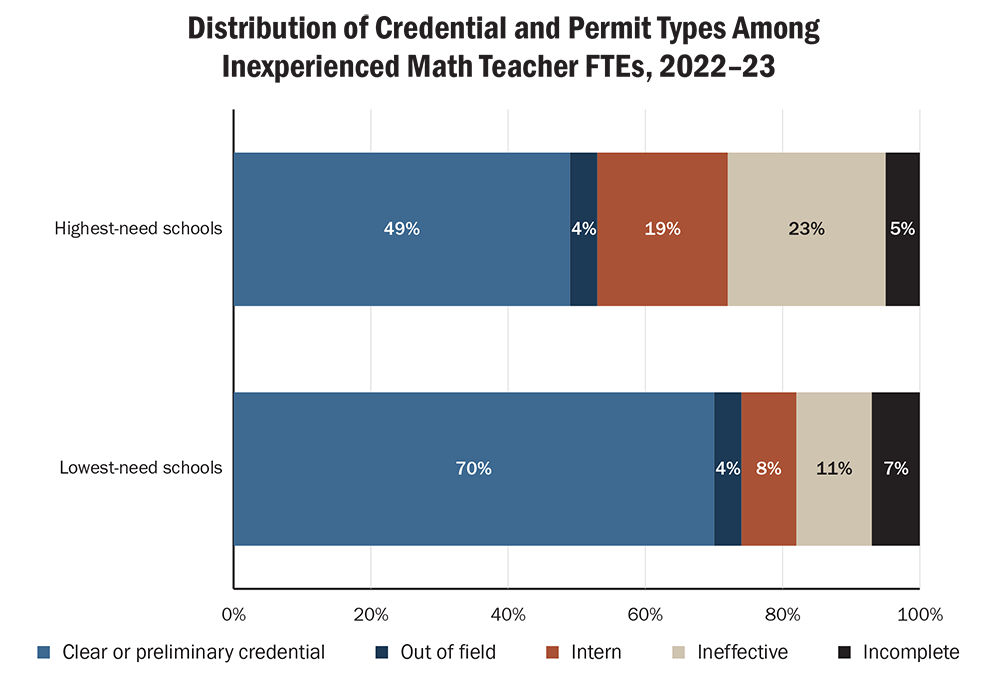Tackling Teacher Shortages: What We Know About California’s Teacher Workforce Investments

Access the Tackling Teacher Shortages: What We Know About California’s Teacher Workforce Investments report for complete research findings.
What is the challenge with California’s teacher workforce?
Like many states, California faces persistent teacher shortages, and school districts find it difficult to fill vacancies with fully credentialed teachers, especially in math, science, special education, and bilingual education. To address shortages, districts often hire underprepared, inexperienced, and substitute teachers, increase class sizes, and cut course offerings altogether. Students of color and those from low-income backgrounds bear the brunt of these consequences, as teacher shortages are most severe in schools serving more of these students. For example, as the figure below from the report shows, fewer than half of new math teachers in schools serving the greatest concentrations of high-need students are fully qualified for their positions, as compared to 70% in lowest-need schools.
Trends in Teacher Shortages
- Teacher production has declined for many years. In 2022, half as many new teachers graduated through a California- based traditional teacher preparation program (TPP) as in 2004, the peak year. As a result, substandard credentials and permits—issued to teachers who haven’t yet earned full teacher certification—have increased, tripling between 2013 and 2023.
- Teacher shortages disproportionately impact students in high-need schools. The state’s highest-need schools (those serving the greatest numbers of low- income and foster care students and English learners) were nearly 3 times as likely to fill teaching positions with interns and teachers on emergency-style permits or waivers than the lowest-need schools.
- California has seen a modest increase in newly prepared teachers. The number of candidates completing traditional TPPs—programs offering candidates coursework and clinical practice through student teaching or a residency—grew by about 10% between 2019 and 2020 and by another 14% in 2021.

What strategies has California invested in?
Between 2018–2023, California invested over $1 billion, mainly in one-time grants, in strategies to strengthen the teacher workforce. Most of these programs just began to be implemented in 2022, so their impacts will largely be felt in the years ahead. Three of California’s largest investments include:
- Teacher Residency Grant Program (TRGP) ($672 million). Supports residency programs that partner local education agencies (LEAs) with TPPs to jointly train and support new teachers. It includes stipends of at least $20,000 as well as other financial supports for residents who commit to teaching in the sponsoring LEA.
- Golden State Teacher Grant (GSTG) Program ($521 million). Provides $10,000–$20,000 in scholarships to teaching candidates enrolled in a TPP and who commit to teaching in a priority school (where students with identified needs—low-income, English learner, or foster care—constitute more than 55% of the student body).
- National Board Certified Teacher (NBCT) Incentive Program ($250 million). To increase the supply of highly accomplished and effective teachers in high-need schools, the program offers a $2,500 subsidy for teachers to pursue National Board certification and a $5,000 annual salary incentive for NBCTs who teach in priority schools for up to 5 years.
How are these investments making a difference?
- The TRGP made strides in addressing shortages and promoting diversity. Teacher residency is becoming an increasingly popular pathway in California, with more than 5,000 candidates in residency programs in the past 3 years. Between 2020 and 2023, nearly 1,400 residents were supported by TRGP funds. Most residents were people of color, and many pursued credentials in severe shortage areas. Of the residents enrolled through 2023, around 40% were enrolled in special education, 34% in STEM fields, and 27% were pursuing bilingual authorization. Analyses have found that residents as a group are more racially and ethnically diverse, feel better prepared to teach, are viewed by supervisors as very well prepared, pass the Teacher Performance Assessment at higher rates, and enter and stay in the workforce at higher rates.
- The GSTG Program, projected to have funds exhausted by 2025, made teaching possible for recipients who commit to teaching in high-need schools. Since its first awards to candidates in the 2021–22 school year, the program has issued more than 22,000 awards. Based on grant recipient interviews, these funds have been crucial for recruiting and retaining candidates who otherwise might not have been able to complete TPPs.
- The NBCT Incentive Program has motivated many Board-certified accomplished teachers to teach and serve as mentors in high-need schools and encouraged others to pursue Board certification, including many teachers of color. The number of candidates pursuing certification—which research shows is linked to teacher effectiveness—more than tripled after the NBCT Incentive Program began in 2022, with the number in high-need schools increasing fourfold from 415 in 2020–21 to 1,764 in 2022–23.
Data show that these programs are gaining traction and appear to be having an impact. California’s investments will be fully realized and understood as funded TPPs ramp up and candidates complete their programs.
What can policymakers do to further strengthen the workforce?
Consistent and reliable funding is needed to continue the momentum. Recommendations include:
- Ensure continued funding for Golden State Teacher Grants, which are projected to be exhausted in 2025. Awards were reduced from $20,000 to $10,000 in 2024–25 to stretch the remaining funds. With additional funding, this program can continue to build a strong pipeline into teaching.
- Plan for sustainability for current teacher residencies and continued expansion. Ongoing state funding can support the establishment of more residency programs, the support of existing residency stipends and expenses, and the research of effective approaches to sustaining and expanding residency programs.
- Support ongoing funding, uptake, and impact studies of the NBCT Incentive Program. Although this program is in its early years of implementation, it has the potential to reach many more teachers with continued investment, support for uptake, and studies of the program's effect in priority schools.
- Gather and report additional data on state workforce programs to understand their use and impact. Currently, data on these programs are limited, and increased data collection is important.
The Bill & Melinda Gates Foundation provided funding for this project.
